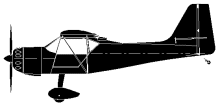
ASN Wikibase Occurrence # 170159
This information is added by users of ASN. Neither ASN nor the Flight Safety Foundation are responsible for the completeness or correctness of this information.
If you feel this information is incomplete or incorrect, you can submit corrected information.
| Date: | Saturday 27 September 2014 |
| Time: | 15:35 |
| Type: |  Denney Kitfox 3 |
| Owner/operator: | Private |
| Registration: | N307KF |
| MSN: | 1040 |
| Year of manufacture: | 1994 |
| Total airframe hrs: | 138 hours |
| Engine model: | Rotax 582 MOD 90 |
| Fatalities: | Fatalities: 1 / Occupants: 2 |
| Aircraft damage: | Substantial |
| Category: | Accident |
| Location: | Near Frontier Airpark (WN53), Lake Stevens, Washington -
 United States of America United States of America
|
| Phase: | Initial climb |
| Nature: | Training |
| Departure airport: | Lake Stevens, WA (WN53) |
| Lake Stevens, WA (WN53) | |
| Investigating agency: | NTSB |
| Confidence Rating: |
The pilot/owner had recently purchased the tailwheel-equipped airplane. He had no experience in tailwheel-equipped airplanes and asked a flight instructor to check him out. The instructor stated that, although he was an experienced tailwheel pilot, he had no experience in the accident airplane make and model, so he flew the airplane solo for about 5 hours in order to become familiar with it. The instructor reported that while flying the airplane solo, he noticed that it would become airborne prematurely if he did not hold the control stick full forward on the takeoff run to keep the airplane on the runway while trying to gain airspeed. The instructor added that he told the pilot/owner about this and cautioned him to hold the control stick full forward on takeoff to prevent the airplane from becoming airborne inadvertently.
During the accident flight, the pilot/owner was in the left seat, and the instructor was in the right seat; the right-seat pilot position was equipped with rudder pedals but not with a control stick. The instructor stated that, during the takeoff run, the airplane became airborne prematurely because the pilot/owner failed to hold the control stick full forward as previously instructed. The instructor reported that he told the pilot/owner to lower the nose after the airplane became airborne and also tried to reach over to move the control stick forward to get the nose down but was not successful because the pilot/owner had frozen on the controls. The airplane subsequently stalled due to the loss of sufficient airspeed and impacted the ground about 225 feet east of the runway in a steep, nose-down attitude. A postaccident examination of the airframe and engine revealed no anomalies that would have preclude normal operation.
Probable Cause: The pilot's failure to maintain airspeed during initial climb, which resulted in the airplane exceeding its critical angle of attack and experiencing an aerodynamic stall. Contributing to the accident was the inability of the flight instructor to take control of the airplane due to the lack of fully operational dual controls in the right-seat pilot position.
Accident investigation:
 |
|
Sources:
NTSB
https://flightaware.com/resources/registration/N307KF
Location
Revision history:
| Date/time | Contributor | Updates |
|---|---|---|
| 28-Sep-2014 03:10 | Geno | Added |
| 29-Sep-2014 22:25 | Geno | Updated [Aircraft type, Registration, Cn, Operator, Source, Narrative] |
| 04-Oct-2014 00:20 | Geno | Updated [Time, Phase, Nature, Departure airport, Source, Narrative] |
| 21-Dec-2016 19:28 | ASN Update Bot | Updated [Time, Damage, Category, Investigating agency] |
| 30-Nov-2017 19:10 | ASN Update Bot | Updated [Other fatalities, Departure airport, Destination airport, Source, Narrative] |
Corrections or additions? ... Edit this accident description
The Aviation Safety Network is an exclusive service provided by:


 ©2024 Flight Safety Foundation
©2024 Flight Safety Foundation